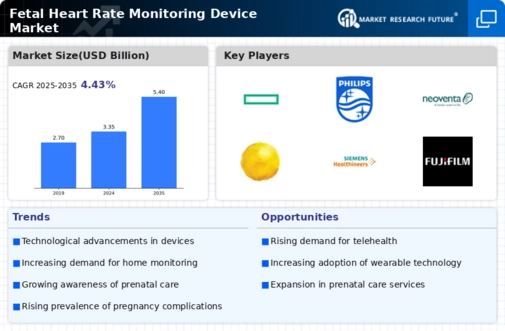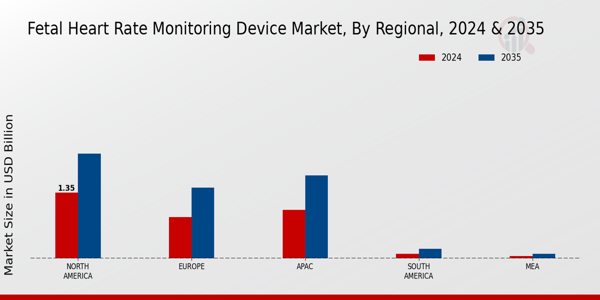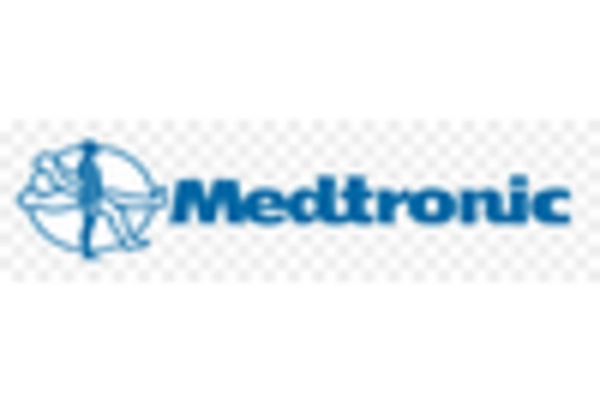Growing Awareness of Fetal Health
Increased awareness regarding fetal health and well-being is significantly influencing the Fetal Heart Rate Monitoring Device Market. Expectant parents are becoming more informed about the importance of monitoring fetal heart rates to detect any anomalies early. This awareness is further fueled by educational campaigns and the proliferation of information through digital platforms. As a result, there is a growing demand for user-friendly and accessible fetal monitoring devices. Market data indicates that the demand for home-based monitoring solutions is on the rise, as parents seek to actively participate in their prenatal care. This trend is likely to encourage manufacturers to innovate and develop devices that cater to the needs of informed consumers, thereby propelling the Fetal Heart Rate Monitoring Device Market forward.
Increased Investment in Maternal Health
Investment in maternal health initiatives is a significant driver for the Fetal Heart Rate Monitoring Device Market. Governments and private organizations are recognizing the importance of maternal health and are allocating resources to improve prenatal care services. This investment often translates into the procurement of advanced fetal monitoring devices, which are essential for ensuring safe pregnancies. Recent reports indicate that funding for maternal health programs has increased by approximately 20% in various regions, reflecting a commitment to enhancing healthcare infrastructure. As these investments continue, the demand for effective fetal monitoring solutions is expected to rise, thereby fostering growth within the Fetal Heart Rate Monitoring Device Market.
Rising Incidence of High-Risk Pregnancies
The Fetal Heart Rate Monitoring Device Market is experiencing growth due to the increasing prevalence of high-risk pregnancies. Factors such as maternal age, pre-existing health conditions, and lifestyle choices contribute to this trend. As the number of high-risk pregnancies rises, healthcare providers are more inclined to utilize advanced fetal monitoring devices to ensure the safety of both mother and child. This heightened demand for effective monitoring solutions is likely to drive innovation and investment in the Fetal Heart Rate Monitoring Device Market. According to recent data, approximately 15% of pregnancies are classified as high-risk, necessitating continuous monitoring to mitigate potential complications. Consequently, the market is poised for expansion as healthcare systems adapt to these challenges.
Technological Innovations in Monitoring Devices
Technological advancements are a key driver in the Fetal Heart Rate Monitoring Device Market. Innovations such as wireless connectivity, mobile applications, and artificial intelligence are transforming how fetal heart rates are monitored. These technologies enhance the accuracy and efficiency of monitoring, allowing healthcare providers to make informed decisions quickly. For instance, devices that integrate with smartphones enable real-time data sharing between patients and healthcare professionals, improving prenatal care outcomes. The market is projected to grow as these innovations become more prevalent, with estimates suggesting a compound annual growth rate of over 8% in the coming years. This trend indicates a robust future for the Fetal Heart Rate Monitoring Device Market as technology continues to evolve.
Regulatory Support for Advanced Monitoring Solutions
Regulatory bodies are increasingly supporting the development and adoption of advanced fetal monitoring solutions, which is positively impacting the Fetal Heart Rate Monitoring Device Market. Streamlined approval processes and guidelines for new technologies encourage manufacturers to innovate and bring new products to market. This regulatory support is crucial in ensuring that healthcare providers have access to the latest monitoring devices that meet safety and efficacy standards. As regulations evolve to accommodate technological advancements, the market is likely to see a surge in new entrants and product offerings. This dynamic environment suggests a promising outlook for the Fetal Heart Rate Monitoring Device Market, as compliance with regulations fosters trust and reliability in fetal monitoring solutions.


















Leave a Comment